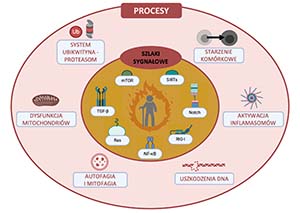Inflammaging - contributing mechanisms and cellular signaling pathways
DOI:
https://doi.org/10.18388/pb.2021_375Abstract
Aging is a multifunctional process which is characterized by many changes on molecular, cellular and tissue levels. The chronic, sterile and low-grade inflammation process, that occurs during aging is referred to as 'inflammaging'. Inflammaging is mentioned as a risk factor for the onset and progression of chronic diseases, not only age-related. Inflammaging contributes to increased morbidity and mortality in elderly individuals, and also affects the lifespan and quality of life. Cell senescence and disturbances in the regulation of inflammasome activation, mitochondrial function, autophagy and mitophagy, ubiquitin-proteasome system and the response to DNA damage contribute to the development of inflammaging. The above processes interact with each other and are modulated by signaling pathways involved in the regulation of the inflammatory response, i.e. NF-kB, mTOR, RIG-I, Notch, TGF-b, Ras pathways, and regulation of sirtuin activity. The aim of the study is to present the processes and signaling pathways underlying inflammaging, including clinical and experimental studies.

Published
Issue
Section
License
Copyright (c) 2021 Advances in Biochemistry

This work is licensed under a Creative Commons Attribution 4.0 International License.
All journal contents are distributed under the Creative Commons Attribution-ShareAlike 4.0 International (CC BY-SA 4.0) license. Everybody may use the content following terms: Attribution — You must give appropriate credit, provide a link to the license, and indicate if changes were made, ShareAlike — If you remix, transform, or build upon the material, you must distribute your contributions under the same license as the original. There are no additional restrictions — You may not apply legal terms or technological measures that legally restrict others from doing anything the license permits.
Copyright for all published papers © stays with the authors.
Copyright for the journal: © Polish Biochemical Society.



